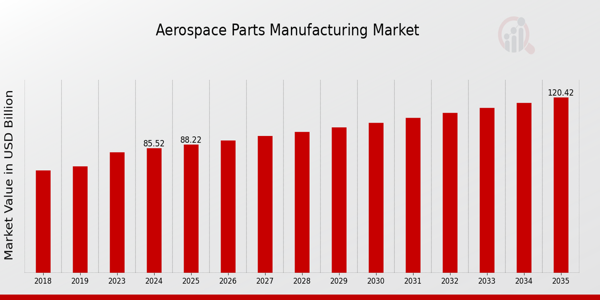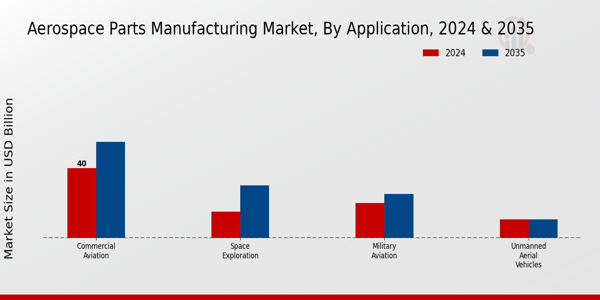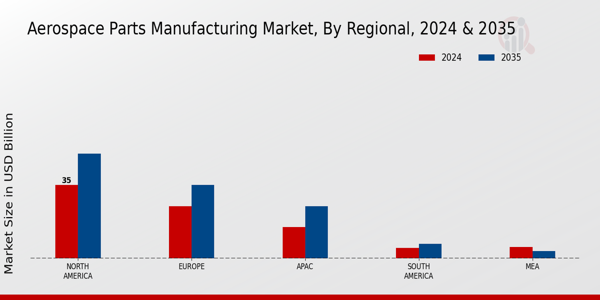Aerospace Parts Manufacturing Market Overview
Aerospace Parts Manufacturing Market Size was estimated at 82.9 (USD Billion) in 2023. The Aerospace Parts Manufacturing Market is expected to grow from 85.52 (USD Billion) in 2024 to 120.5 (USD Billion) by 2035. The Aerospace Parts Manufacturing Market CAGR (growth rate) is expected to be around 3.16% during the forecast period (2025 - 2035).
Key Aerospace Parts Manufacturing Market Trends Highlighted
The growing need for air travel and technological developments are driving the considerable expansion of the aerospace parts manufacturing market. One of the main factors driving the market is the growth of the commercial aviation industry, which is pushing producers to increase their capacity for manufacturing.
Furthermore, rising concerns about the efficiency and safety of airplanes are driving up investments in premium components and materials. Due to their ability to improve performance and fuel efficiency, lightweight materials like composites and alloys are also having an impact on the industry.
The use of additive manufacturing, or 3D printing, which can produce more individualized and affordable parts, is one opportunity to be investigated in the worldwide market. Lead times can be greatly shortened by this technology, which also makes it easier to create intricate geometries that conventional production techniques could find difficult to achieve.
The increasing prevalence of collaborations between technology businesses and aerospace corporations underscores the potential for breakthroughs that have the potential to revolutionize supply chain logistics and part manufacturing. Trends like environmental responsibility and sustainability have been more popular in this industry in recent years.
Manufacturers are putting more and more effort into cutting their carbon footprint by producing aerospace parts using creative, environmentally friendly methods. Additionally, supply chain resilience has gained importance as businesses work to maintain dependability and continuity in the face of worldwide disruptions.
Furthermore, worldwide operations are still impacted by geopolitical considerations and regulatory changes, which calls for manufacturers to adopt flexible methods. These patterns demonstrate how dynamic the worldwide aerospace components production environment is.

Source Primary Research, Secondary Research, MRFR Database and Analyst Review
Aerospace Parts Manufacturing Market Drivers
Increasing Demand for Commercial Aircraft
The Aerospace Parts Manufacturing Market is significantly driven by the increasing demand for commercial aircraft. According to the International Air Transport Association, air passenger traffic is projected to grow at an annual rate of 4.1 percent, leading to a substantial increase in the number of aircraft required.
This growth translates into a need for more aerospace parts, as manufacturers like Boeing and Airbus ramp up production to meet this demand. Additionally, emerging economies are expanding their air transport networks, further fueling the requirement for aerospace parts across various aircraft models.
With the fleet expected to double in size in the next two decades, the demand for high-quality aerospace components is poised for significant growth. This trend directly correlates with the increase in production volumes in the Aerospace Parts Manufacturing Market, which is expected to benefit from both existing and new entrants in the industry.
Technological Advancements in Manufacturing Processes
The adoption of advanced manufacturing technologies such as 3D printing, digital twin technology, and automation is reshaping the Aerospace Parts Manufacturing Market. Companies like Lockheed Martin and GE Aviation are investing heavily in Research and Development to innovate production methods, thus enhancing efficiency and reducing costs.
For instance, the use of additive manufacturing has enabled the production of complex aerospace parts with reduced lead times and waste, making it a game changer for the industry. Studies suggest that the implementation of smart manufacturing technologies can improve productivity by up to 30 percent, thereby positively affecting market growth.
Growing Investment in Defense and Military Aircraft
geopolitical tensions have resulted in increased defense spending across various countries, thereby driving the demand for military aircraft. Countries such as the United States, China, and India are investing significantly in their defense capabilities, with the Stockholm International Peace Research Institute reporting an increase in military expenditure by approximately 2.6 percent annually.
This trend has led to a higher demand for specialized aerospace parts that cater to defense aircraft, driving growth in the Aerospace Parts Manufacturing Market. Established defense contractors like Northrop Grumman and Raytheon are expanding their production capabilities to meet this rising demand, effectively shaping the market landscape.
Aerospace Parts Manufacturing Market Segment Insights
Aerospace Parts Manufacturing Market Application Insights
The Aerospace Parts Manufacturing Market, with a focus on the Application segment, reflected significant opportunities and growth across various sectors, positioning it for a robust trajectory in the coming years.
Within this landscape, the most prominent area was Commercial Aviation, valued at 40.0 Billion USD in 2024. This segment played a vital role, making up nearly 47% of the market share, driven by increasing air travel demand and the need for advanced aircraft technology. As passenger numbers continue to rose, this section is expected to dominate further, reaching an estimated 55.0 Billion USD by 2035.
Similarly, the Military Aviation segment followed, representing significant market potential at 20.0 Billion USD in 2024 and expected to grow to 25.0 Billion USD by 2035. The ongoing geopolitical tensions and the need for defense modernization are major drivers in boosting this sector's relevance and demand.
In the realm of Space Exploration, valued at 15.0 Billion USD in 2024, the segment gained momentum due to increasing investments and innovations in space travel, aiming for advancements like reusable rockets and potential missions to Mars. By 2035, this segment could see its value double, emphasizing its importance in redefining humanity’s boundaries in space.
Lastly, while the Unmanned Aerial Vehicles segment stood at 10.52 Billion USD in 2024 and is projected to slightly decline to 10.5 Billion USD by 2035, it represented a vital innovation area, focusing on drones for a variety of applications like surveillance, delivery, and emergency services. The unique applications of these vehicles combine to contribute to efficiency and safety improvements in multiple industries.
The Aerospace Parts Manufacturing Market exhibited a multifaceted structure that caters to diverse aerospace needs, showing the significance of each segment in shaping the future of air transportation and exploration on a scale.
Advances in technology and rising consumer expectations drive a growing demand across all these segments, promoting a continuous evolution in aerospace manufacturing and the industry's overall market landscape.

Source Primary Research, Secondary Research, MRFR Database and Analyst Review
Aerospace Parts Manufacturing Market Type of Parts Insights
The Aerospace Parts Manufacturing Market encompasses a broad array of components categorized by their type, crucial for the aerospace industry's growth and functionality. Among these, Structural Components play a vital role as they ensure the integrity and safety of aircraft, leading to their dominance in the sector.
Meanwhile, Engine Components are essential for enhancing performance and fuel efficiency, reflecting trends towards sustainability in aviation. Furthermore, Electrical Components are increasingly significant as air travel moves towards greater automation and digitalization, a trend expected to boost demand in this area.
Lastly, Interior Components focus on passenger comfort and experience, critical in an era where customer satisfaction is paramount for airline competitiveness.
The Aerospace Parts Manufacturing Market segmentation illustrates how these various types collectively contribute to a robust industry that is forecasted to expand further, driven by advancing technologies and increasing air traffic globally, as supported by government reports and industry standards.
This robust market growth is supported by ongoing innovation and an emphasis on improving safety and efficiency across all component types.
Aerospace Parts Manufacturing Market Material Insights
The Aerospace Parts Manufacturing Market showcases a diverse Material segment that plays a crucial role in the industry. This segment encompasses several key materials, including Aluminum, Titanium, Composite Materials, and Steel, each contributing significantly to performance, safety, and efficiency.
Aluminum is known for its lightweight properties and excellent corrosion resistance, making it a dominant choice for many aircraft components. Titanium, renowned for its high strength-to-weight ratio, is predominantly utilized in critical structural components, ensuring durability in extreme conditions.
Composite Materials offer superior strength and reduced weight, increasingly favored in modern aircraft designs for fuel efficiency. Steel, despite being heavier, remains vital in specific applications requiring high strength and fatigue resistance.
As the Aerospace Parts Manufacturing Market continues to evolve, these materials reflect ongoing trends toward lightweighting and advanced engineering practices to meet sustainability goals and enhance overall performance.
As the industry adapts to new technologies and regulations, understanding the dynamics of the Material segment becomes essential for anticipating market growth and opportunities.
Aerospace Parts Manufacturing Market End Use Insights
The Aerospace Parts Manufacturing Market displays a significant structure in its End Use segment, primarily divided into Original Equipment Manufacturer and Aftermarket categories. The Original Equipment Manufacturer sector plays a crucial role as it involves the production of parts utilized in the assembly of aircraft, which remains a core aspect of the aerospace industry's growth and innovation.
This segment is vital as it also encompasses advanced technologies and increasingly efficient manufacturing processes. Conversely, the Aftermarket segment represents a substantial share of the market, focusing on the maintenance, repair, and overhaul of existing aircraft, which is essential for ensuring safety and extending the lifecycle of aircraft components.
This interplay between both categories provides a comprehensive picture of the market, reflecting the ongoing demand for high-quality aerospace parts.
The consistent market growth is driven by rising air travel and advancements in aerospace technologies, making the End Use segmentation a key area of focus for stakeholders looking to capitalize on emerging opportunities in the Aerospace Parts Manufacturing Market.
Aerospace Parts Manufacturing Market Regional Insights
The Aerospace Parts Manufacturing Market showcased a diverse regional segmentation, with notable variations in market value and growth potential. In 2024, North America stood as a dominant force, valued at 35.0 USD Billion, and is projected to reach 50.0 USD Billion by 2035, driven by advanced aerospace technology and a well-established manufacturing base.
Europe followed, holding a market valuation of 25.0 USD Billion in 2024, growing to 35.0 USD Billion by 2035, with strong emphasis on innovation and regulatory compliance. The APAC region, valued at 15.0 USD Billion in 2024, is expected to achieve 25.0 USD Billion by 2035, reflecting increasing demand for commercial and military aircraft in emerging economies.
South America, while smaller in comparison, was valued at 5.0 USD Billion in 2024 and is set to grow to 7.0 USD Billion, as local manufacturing capabilities expand due to increasing investments. However, the MEA region, initially valued at 5.52 USD Billion in 2024, is likely to decline to 3.5 USD Billion by 2035, possibly due to geopolitical challenges and market accessibility issues.
Overall, the Aerospace Parts Manufacturing Market segmentation indicated a dynamic landscape influenced by regional demand, technological advancements, and economic conditions.

Source Primary Research, Secondary Research, MRFR Database and Analyst Review
Aerospace Parts Manufacturing Market Key Players and Competitive Insights
The Aerospace Parts Manufacturing Market presents a complex landscape characterized by an intense level of competition, driven by technological advancements, rising demand for fuel-efficient aircraft, and the ongoing recovery from the COVID-19 pandemic.
Competition in this market is robust, marked by a mix of established multinational corporations and innovative smaller firms that are continually striving to enhance their product offerings. Factors influencing competition include the development of lighter materials, advancements in digital technology, and shifts in customer preferences towards sustainability.
Additionally, geopolitical factors can impact supply chains and market access, creating both challenges and opportunities for market players. A focus on research and development, alongside strategic partnerships and collaborations, is essential for gaining a competitive edge and achieving long-term growth in this rapidly evolving market.
Rockwell Collins maintains a strong presence in the Aerospace Parts Manufacturing Market, leveraging its extensive expertise in avionics and aircraft systems. The company is recognized for its innovative products, which enhance the efficiency and reliability of aerospace operations.
One of Rockwell Collins's key strengths lies in its ability to integrate cutting-edge technology with existing systems, providing solutions that not only meet current aerospace standards but also anticipate future demands. The company has built strong relationships with various aircraft manufacturers and suppliers, positioning itself as a preferred partner in numerous aerospace projects around the globe.
This robust market presence underscores Rockwell Collins's commitment to excellence in product development, high-quality manufacturing, and comprehensive customer support, which further solidifies its competitive standing within the industry.
Airbus is a dominant player in the Aerospace Parts Manufacturing Market with a recognized reputation for manufacturing commercial aircraft, helicopters, and military systems.
The company’s strength lies in its broad portfolio of key products and services, including the innovative A320, A350, and A380 aircraft, which have become benchmarks in the aviation industry due to their efficiency and performance. Airbus has strategically focused on sustainability by integrating environmentally-friendly technologies into its designs.
The company has further enhanced its market position through a series of mergers and acquisitions aimed at expanding its technological capabilities and market reach. Airbus’s commitment to research and development ensures continuous innovation, while its supply chain and partnerships enhance its operational efficiency.
Overall, Airbus's comprehensive approach to product offerings and strategic growth initiatives firmly established it as a leading force in the aerospace parts manufacturing landscape.
Key Companies in the Aerospace Parts Manufacturing Market Include
- Rockwell Collins
- Airbus
- GE Aviation
- Bombardier
- Northrop Grumman
- Leonardo
- RollsRoyce
- Boeing
- Lockheed Martin
- MTU Aero Engines
- Raytheon Technologies
- Honeywell
- Safran
- General Dynamics
- Thales Group
Aerospace Parts Manufacturing Market Developments
Recent news developments in the Aerospace Parts Manufacturing Market indicate significant activity among major players such as Boeing, Airbus, and GE Aviation, reflecting a focus on innovation and sustainable practices.
In October 2023, Boeing announced an increase in production rates to meet the rising demand for commercial aircraft, which has accelerated due to the recovery from the pandemic. In September 2023, Airbus unveiled its strategy for integrating advanced technologies into its manufacturing processes, highlighting the shift towards automation and digitalization.
Furthermore, in August 2023, GE Aviation expanded its partnership with Safran to enhance the development of next-generation engines, aiming for improved fuel efficiency. There have also been noteworthy mergers and acquisitions, with Lockheed Martin acquiring Aerojet Rocketdyne in March 2022, bolstering its position in the aerospace propulsion sector.
The market is witnessing an overall valuation growth driven by the increasing demand for lightweight materials and advanced manufacturing techniques, with a projected growth rate of approximately 4.2% annually. This trend is further supported by ongoing government initiatives globally to promote aerospace innovation and infrastructure development, ensuring competitiveness in the industry.
Aerospace Parts Manufacturing Market Segmentation Insights
Aerospace Parts Manufacturing Market Application Outlook
- Commercial Aviation
- Military Aviation
- Space Exploration
- Unmanned Aerial Vehicles
Aerospace Parts Manufacturing Market Type of Parts Outlook
- Structural Components
- Engine Components
- Electrical Components
- Interior Components
Aerospace Parts Manufacturing Market Material Outlook
- Aluminum
- Titanium
- Composite Materials
- Steel
Aerospace Parts Manufacturing Market End Use Outlook
- Original Equipment Manufacturer
- Aftermarket
Aerospace Parts Manufacturing Market Regional Outlook
- North America
- Europe
- South America
- Asia Pacific
- Middle East and Africa
|
Report Attribute/Metric
|
Details
|
|
Market Size 2023
|
82.9(USD Billion)
|
|
Market Size 2024
|
85.52(USD Billion)
|
|
Market Size 2035
|
120.5(USD Billion)
|
|
Compound Annual Growth Rate (CAGR)
|
3.16% (2025 - 2035)
|
|
Report Coverage
|
Revenue Forecast, Competitive Landscape, Growth Factors, and Trends
|
|
Base Year
|
2024
|
|
Market Forecast Period
|
2025 - 2035
|
|
Historical Data
|
2019 - 2024
|
|
Market Forecast Units
|
USD Billion
|
|
Key Companies Profiled
|
Rockwell Collins, Airbus, GE Aviation, Bombardier, Northrop Grumman, Leonardo, RollsRoyce, Boeing, Lockheed Martin, MTU Aero Engines, Raytheon Technologies, Honeywell, Safran, General Dynamics, Thales Group
|
|
Segments Covered
|
Application, Type of Parts, Material, End Use, Regional
|
|
Key Market Opportunities
|
Increased demand for lightweight materials, Growth in unmanned aerial vehicle production, Advancements in 3D printing technologies, Expansion in electric aircraft manufacturing, Rising need for aftermarket services
|
|
Key Market Dynamics
|
Technological advancements, demand growth, Regulatory compliance pressures, Supply chain disruptions, Increased competition
|
|
Countries Covered
|
North America, Europe, APAC, South America, MEA
|
Aerospace Parts Manufacturing Market Highlights:
Frequently Asked Questions (FAQ) :
The Aerospace Parts Manufacturing Market was valued at 85.52 USD Billion in 2024.
By 2035, the Aerospace Parts Manufacturing Market is projected to reach a value of 120.5 USD Billion.
The expected CAGR for the Aerospace Parts Manufacturing Market from 2025 to 2035 is 3.16%.
North America dominated the Aerospace Parts Manufacturing Market with a value of 35.0 USD Billion in 2024.
The market size for Military Aviation is expected to be 25.0 USD Billion by 2035.
The market size for Commercial Aviation was 40.0 USD Billion in 2024 and is expected to reach 55.0 USD Billion in 2035.
Major players in the market include Rockwell Collins, Airbus, GE Aviation, Bombardier, Northrop Grumman, and more.
The APAC region is expected to see market growth from 15.0 USD Billion in 2024 to 25.0 USD Billion by 2035.
The Space Exploration segment is projected to grow to 30.0 USD Billion by 2035.
Potential challenges include technological advancements and fluctuations in government defense spending impacting military aviation.

















